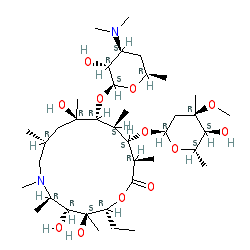GtoPdb is requesting financial support from commercial users. Please see our sustainability page for more information.
|
azithromycin is an approved drug (FDA & UK (1991))
Compound class:
Synthetic organic
Comment: Azithromycin is a macrolide antibacterial with broad-spectrum activity against Gram-positive and atypical bacteria. The compound also has antimalarial activity.
Azithromycin is one of the watch group antibacterials in the the World Health Organization's Model List of Essential Medicines (link provided in the Classification table below). The Malaria tab on this ligand page provides additional curator comments of relevance to the Guide to MALARIA PHARMACOLOGY. Ligand Activity Visualisation ChartsThese are box plot that provide a unique visualisation, summarising all the activity data for a ligand taken from ChEMBL and GtoPdb across multiple targets and species. Click on a plot to see the median, interquartile range, low and high data points. A value of zero indicates that no data are available. A separate chart is created for each target, and where possible the algorithm tries to merge ChEMBL and GtoPdb targets by matching them on name and UniProt accession, for each available species. However, please note that inconsistency in naming of targets may lead to data for the same target being reported across multiple charts. ✖ |
|
|||||||||||||||||||||||||||||||||||
| No information available. |
Summary of Clinical Use  |
| Azithromycin is approved for use in both the US and the UK. It is also available in other countries under various trade names, click here to link to Drugs.com's list of internationally marketed azithromycin drugs. |
Mechanism Of Action and Pharmacodynamic Effects  |
| Although the mechanism of action in the Plasmodium parasite has not been fully elucidated, it is thought that azithromycin inhibits the production of proteins encoded by the apicoplast genome, leading to a subsequent loss of apicoplast function and a possible explanation for the delayed antimalarial effect [2]. |
External links  |
|
For extended ADME data see the following: Electronic Medicines Compendium (eMC) Drugs.com |










